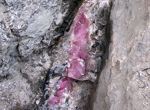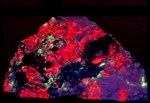Tugtupite Info
Back to Tugtupite
In 1957, European geologists discovered tugtupite in Greenland although the Greenlandic Inuit knew this mineral since centuries. They named this red mineral according to the reindeer ("tuttu") blood.
Apart from Greenland, tugtupite has been found only in Canada (Mont St. Hilaire) and Russia (Lovozero Massif / Kola Peninsula). Only Greenland can supply the market with sufficient quantities of worthy, sometimes deeply red and highly demanded tugtupite. The finest stones are usually reserved for jewelry.
Deposits in Greenland
 |
| South Greenland |
 |
| Ilímaussaq Complex * |
The area is scarcely covered with plants, very much weather-beaten and rising from SE to NW. Mount Ilímaussaq (1390 m) is the highest point. The whole area can be reached only in summer, by foot. Collectors should rely on experienced, trained leaders to cope with dangerous situations.
Color and Fluorescence
Color
 |
| Color Change * |
 |
| Tugtupite Vein * |
Tugtupites may show also a reaction when kept warm. Inuit say that some stones turn into a deeper red according to the intensity of a romance.
Fluorescence
 |
| UV Fluorescence * |
Pale pink tugtupite from the Taseq area shows a different UV response: a weaker red under SW UV, salmon-orange under LW UV and pinkish-lavender under midwave UV. This tugtupite phosphoresces strongly white to cream.
To make the UV response even more complex, stones from other locations of the Ilímaussaq Complex show a pinkish-orange under SW UV, a very bright white under mid-wave UV and orange under LW UV, also phosphorescent.
Quality
Translucent or transparent, deep red (in daylight) stones from Kvanefjeld are used for jewelry (rings, necklaces etc.). Inuit artisans raise their income by cutting the stones into cabochons, polishing them and selling them.
Better tugtupite stones are translucent and without any visible other material. The best stones are nearly transparent and much sought after by gemstone enthusiasts although one has to consider the Mohs hardness of only 4.
* Photos by kind permission of © www.minershop.com, Mark Cole who also offers guided Mineral Geo Adventure Tours to the major sites within the Ilímaussaq Complex.
* Photos by kind permission of © www.fourth-millennium.net, Corby Waste.
⇐ Intro Page ⇐ Gemstones ⇐ Tugtupite